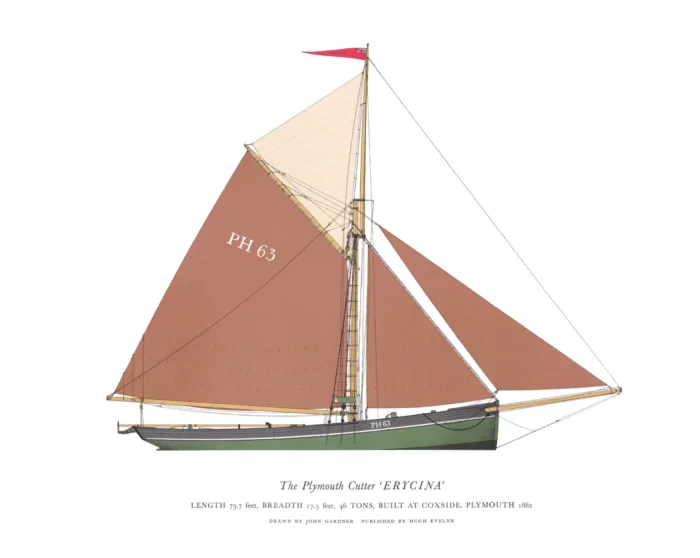Plymouth Cutter, Erycina, 1882
£15.00
Ericyna: Plymouth Cutter (scroll down for a more detailed Description)
Published 1964 by © Hugh Evelyn Limited; drawn by Scottish marine artist John Gardner (1930-2010)
Size: 43 x 35 cm [17” x 14”] (may vary slightly from printers’ cut 60 years ago)
Printed on white matt cardstock c. 133 g/sm2
Print is LARGE size – shippings LARGE size – shipping is the same for 1 to 10 prints (based on largest print size in your order) – see Shipping & Returns
In stock
- Satisfaction Guaranteed
- No Hassle Refunds (see Shipping and returns)
- Secure Payments
Description
Plymouth Cutter;
Built as a cutter 1882; Converted to ketch rig: 1894;
Built: by W.H. Shilston at Coxside, Sutton Harbour, Plymouth, UK;46 tons; Leingth: 74 ft (23 M) Beam: 18 ft (5 M);
Brixham vessels were used throughout the South. Erycina, a large cutter, was launched in 1882. Large sail area, long bow and mast stepped well aft characterised many Devon vessels. Built for speed and big Atlantic seas her heavy scantlings were typical of the period. 2 ½ in yellow pine planks fastened to doubled 3 x 3 ½ inch oak frames by treenails, or oak pegs, split and caulked. 30 tons of pig iron ballast (kentledge), stowed in the bilges. Cutter rigged with a large loose-footed mainsail, topsail, foresail and jib set flying on the bowsprit. A big tow foresail on the forestay. In light air or fishing for hake, to keep nets clear of the bottom, a couple of square sails were set on the weather side. Some trawlers fitted reef points on their sails. Erycina, in common with most, had lacing eyes. Taking in a reef was a big job; a man stood in the belly of the sail, often full of water, to pass 10 fathoms of 1 ½ in rope through each eyelet under the foot of the sail, working aft to forward. A 40-ft bowsprit projected 28 ft outboard of the stem – a running spar hauled inboard in harbour or under reduced sail. A 50 ft boom in a light oily swell where the vessel tended to roll, this great spar swinging about was a danger and put severe strain on the rigging. The low freeboard is not apparent from the illustration because of the high bulwarks which disguise the fact that the hull is two-and-a-half times larger under water. The heavily-ballasted hull made for good carrying ability. The low freeboard gave a convenient platform to handle the nets. With little reserve buoyancy or lift for a hull of such displacement, in heavy weather, especially when working to windward, her decks were liable to be well washed down.
Additional information
| Dimensions | 44.5 × 35.5 cm |
|---|




